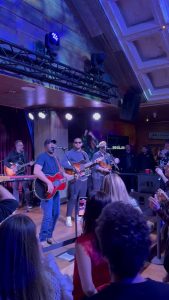For over 25 years now, Praneet Marathe has been learning harmonium from his father, a renowned music professional. Marathe, who also has a recorded airing on All India Radio and a nationally acclaimed scholarship from the Ministry of Culture, Government of India, to his credit, has now developed a new age notation system for music learners in the digital age.
Also Read: Mercury’s Munich: Freddie’s best years in the city
Having developed a new ‘swaralipi’ or notation system that can be adopted while learning online, Marathe emphasizes the need for structured and focussed learning modules so modern learners make quick progress in music learning. His ongoing research comes as a fresh perspective on how classical music is taught and learnt in the digital age.
Marathe proposes that this new material be used to train students in basic and advanced concepts . He talks about this new invention and plans in an interview with Opoyi.
Excerpts from the interview
Opoyi: How did it all start? Can you share your journey with us?
Answer: My musical journey started when I was 6 years old. I started learning harmonium from my father. At the age of 12, I played my first concert and since then I have played with many Indian classical musical stalwarts in India and abroad. I have played in major concerts such as Pune Festival and Yuva Sangeet Samaroh Pune to name a few. I have also accompanied in concerts for All India Radio. I received a scholarship from the Ministry of Culture, Government of India. I have played an important role in Gandharva Mahavidyalaya, creating a curriculum for music and crafting learning material, as a harmonium faculty.
Also Read: Outtakes from Beatles documentary ‘Let it Be’ reveals their rare connection
Opoyi: What inspired you to come up with the new notation system? How does it work?
Answer: Over the period of time, as more students started learning music online, it has become increasingly difficult for teachers to train. Many teachers who don’t have the required material already printed spend hours writing notations of compositions, taking pictures, and sharing them with their students. They cannot use the tools on the computer as the symbols in the script are not available. Special fonts and software are needed to digitize the notation, which requires specialized resources. And as we make advancements in the way music is taught, some things should evolve as well, one of which is the notation system.
While teaching at Gandharva Mahavidyalaya, I felt the need of having a system that is easier to write, check and follow. When it comes to examining students, one cannot use the traditional system online. As a music teacher and a performer, I always think of ways to make it easier for students to learn and practice music.
Students are learning music online more than ever. It is hard for the teacher to see if students and check for mistakes.
Also Read: Grammy Awards 2022 blurs genre lines, ushers in a retiree revolution
Opoyi: How does it work?
Answer: In a music notation system, there are some fundamental components-
Symbols for matras
Symbols for komal, teevra swar, mandra saptak, taar saptak
Taal matra indicators
Bol (in case of vocal)
In the traditional Paluskar system, for an instrumental music composition (which does not have bol/lyrics, only swaras) a multi-line system is used where the first row contains swaras, in the second row matras and third row taal indicators. This makes formatting very crucial. If the swaras and matras are not aligned it can lead to misinterpretation. The new system makes it easy and has everything in one line – taal indicators followed by swaras followed by matras, so there is a grouping of 3-4 characters for each swara. It uses some of the symbols from Paluskar lipi to make it easier for people to understand and introduces some new symbols readily available on the computer keyboard for easier typing on digital devices.
Opoyi: How can one have access to it and learn?
Answer: To use the system students need to know the symbols and framework. Students can learn from books published by Gandharva Mahavidyalaya, Pune. This system can be used in any language, Hindi, English or Marathi. Students would be able to take notes while listening to the guru on a digital device and send them across to the guru for verification. The teacher can check instantly and suggest edits.
Also Read: Ed Sheeran to feature in Pokémon GO and internet can’t keep calm
Any musician, teacher or student can easily take notes without needing pen and paper. There can be so many things that can be done down the line. The opportunities are endless, such as creating a new keyboard for mobile apps that has only the necessary symbols and letters, eliminating the clutter. An app could also be developed which takes this notation as input and converts the notation into the traditional notation systems.
Opoyi: Your views on how classical music is taught and learnt using new age technologies?
Answer: Classical music is now taught via Zoom, Skype and various other video conferencing apps. The traditional way was to learn via “guru shishya parampara” where the disciple used to stay at the guru’s house to learn. I truly believe both ways of learning are great. If you want to be a professional musician, you need to learn art in person and there is no substitute. If you are learning music as a hobby, it’s okay to learn online, which is more convenient.
Also Read: Rapper Young Dolph, 36, shot dead at Tennessee cookie shop: Police
Opoyi: How do you feel the internet has impacted classical music learning?
Answer: I think the Internet has impacted positively. We can look at this from different standpoints.
As a performer – I can sell my content online, I can reach wider audiences across the globe.
As a teacher – I can teach music from anywhere in the world.
As a student/listener – I can learn from anyone I like. There is so much content on Youtube that is free.
Overall speaking, the internet has elevated the learning, teaching, performing, as well as listening experiences.
Opoyi: What do you feel needs to be done to expand classical music audiences/listeners?
Answer: Classical music/arts is perceived as something that is very complicated to learn, I think music performers and teachers can educate audiences in a simplified way. We are doing this at Gandharva Mahavidyalaya.
Opoyi: What are your plans?
Answer: I want to leverage technology to help students learn more efficiently. My goal is to develop tools and platforms for students learning online to overcome some of the challenges. Developing an app for music learning is on my radar as well as publishing new books with high-quality training material.






